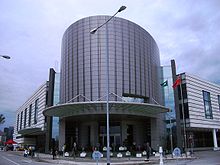This is an old revision of this page, as edited by The Anome (talk | contribs) at 09:02, 19 October 2010 (Reverted edits by The Anomebot2 (talk) to last version by Fat pig73). The present address (URL) is a permanent link to this revision, which may differ significantly from the current revision.
Revision as of 09:02, 19 October 2010 by The Anome (talk | contribs) (Reverted edits by The Anomebot2 (talk) to last version by Fat pig73)(diff) ← Previous revision | Latest revision (diff) | Newer revision → (diff) |
| Politics and government of Macau |
| Laws |
Executive
|
Legislature
|
Judiciary
|
Districts
|
Elections
|
| Foreign relationsDocuments |
| Related topics |

| Leal Senado Building | |||||||
|---|---|---|---|---|---|---|---|
 | |||||||
| Chinese name | |||||||
| Traditional Chinese | 民政總署大樓 | ||||||
| |||||||
| Portuguese name | |||||||
| Portuguese | Edifício do Leal Senado | ||||||

The Leal Senado, Portuguese for Loyal Senate, was the seat of Macau's government (Legislative Assembly of Macau) during its time as a Portuguese colony. It is located at one end of the Senado Square. The title was bestowed on Macau's government in 1810 by Portugal's Prince-Regent João, who would later become King John VI of Portugal. This was a reward for Macau's loyalty to Portugal during the Iberian Union, between 1580 and 1640.
The building itself was erected in 1784. After the handover of Macau to China in 1999 it became the headquarters of the Institute of Civic & Municipal Affairs (Template:Lang-pt).
It became part of the UNESCO World Heritage Site Historic Centre of Macau in 2005.
References
- Shipp, Steve: Macau, China: A Political History of the Portuguese Colony's Transition to Chinese Rule
External links
- Ola Macau Guide - entry on the Leal Senado building
This Macau location article is a stub. You can help Misplaced Pages by expanding it. |